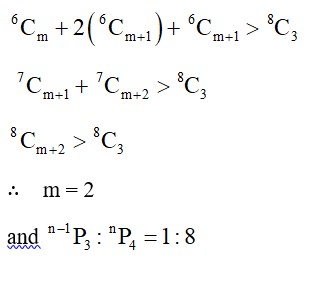If ⁿPᵣ = ⁿPᵣ₊₁ and ⁿCᵣ = ⁿCᵣ₋₁, then the value of r is equal to:
If ⁿPᵣ = ⁿPᵣ₊₁ and ⁿCᵣ = ⁿCᵣ₋₁, then the value of r is equal to:
Option 1 -
4
Option 2 -
1
Option 3 -
3
Option 4 -
2
-
1 Answer
-
Correct Option - 4
Detailed Solution:? P? =? P? ⇒ n!/ (n-r)! = n!/ (n-r-1)! ⇒ n-r=1.
? C? =? C? ⇒ r + (r-1) = n ⇒ n = 2r-1.
Substitute n: (2r-1)-r=1 ⇒ r=2.
Similar Questions for you
Start with
(1)
(2)
(3) GTE : 4!, GTN: 4!, GTT : 4!
(4) GTWENTY = 1
⇒ 360 + 60 + 60 + 24 + 24 + 24 + 1 = 553
x + 2y + 3z = 42
0 x + 2y = 42 ->22 cases
1 x + 2y = 39 ->19 cases
2 x + 2y = 36 ->19 cases
3 x + 2y = 33 ->17 cases
4 x + 2y = 30 ->16 cases
5 x + 2y = 27 ->14 cases
6 x + 2y = 24 ->13 cases
7 x + 2y = 21 ->11 cases
8 x + 2y = 18 ->10 cases
9 x + 2y = 15 ->8 cases
10 x + 2y =12 -> 7 cases
11 x + 2y = 9 -> 5 cases
12 x + 2y = 6 -> 4 cases
13 x + 2y = 3 -> 2 cases
14 x + 2y = 0 -> 1 cases.
Total ways to partition 5 into 4 parts are:
5 0
4 1 0
3 2 0
3 1 0
2 1
51 Total way
After giving 2 apples to each child 15 apples left now 15 apples can be distributed in
15+3–1C2 = 17C2 ways
Taking an Exam? Selecting a College?
Get authentic answers from experts, students and alumni that you won't find anywhere else
Sign Up on ShikshaOn Shiksha, get access to
- 65k Colleges
- 1.2k Exams
- 679k Reviews
- 1800k Answers




